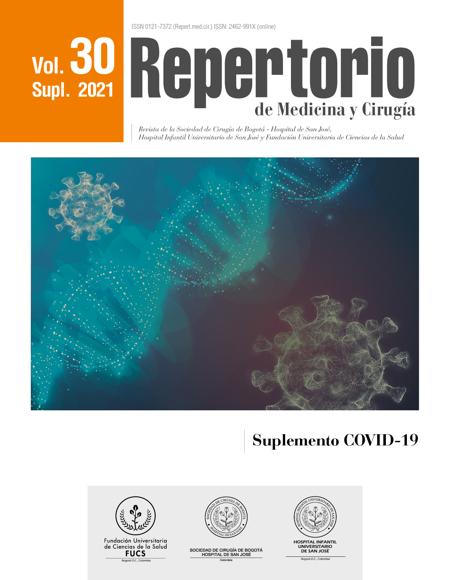Estimated time to reach global herd immunity against COVID-19
Perspectiva del tiempo para alcanzar la inmunidad de rebaño para COVID-19 a nivel mundial
![]()
![]()

Show authors biography
Introduction: humanity faces the greatest vaccination campaign in history. The immunization process against COVID-19, which started in early December 2020 in the United States, United Kingdom, Russia and China, is underway worldwide and is emphasized in most of the wealthiest countries. Objective: to estimate the time to reach global herd immunity against COVID-19, relying on the vaccination data released by Johns Hopkins University. Methodology: global daily vaccination data was obtained from Johns Hopkins University. The period as to June 30 2021 was reviewed. Results: it was determined that herd immunity will be achieved by January 19 2022. As of this date 11.034.357.235 doses will have been administered to immunize the world´s population. Conclusion: from this research we infer the significant role that mathematical models play when simulating vaccination processes, thus, future research avenues based on mathematical modeling to achieve herd immunity for any infectious process, will be designed.
Article visits 2111 | PDF visits 1107
Downloads
- Ordaz A, Oliveres V, Sáchez R. Así avanza la vacunación: mapas y gráficos sobre su evolución en España y el mundo [Internet]. 2021 [citado junio 12 de 2021]; Disponible en: https://www.eldiario.es/sociedad/vacuna-covid-mapas-graficos-proceso-vacunacion-espana-mundo-junio-10_1_6782953.html
- Gutiérrez, J. La competición por las vacunas pone en riesgo la inmunización en los países con menos recursos [Internet]. 2021 [citado junio 12 de 2021]. Disponible en: https://www.rtve.es/noticias/20210611/vacuna-coronavirus-mundo/2073422.shtml
- Boland, B. ¿Qué es la inmunidad de rebaño? [Internet]. [citado abril 10 de 2021]; Disponible en: https://www.bannerhealth.com/es/healthcareblog/teach-me/what-is-herd-immunity
- Cochrane Iberoamérica. Inmunidad de grupo (inmunidad de rebaño) y COVID-19 [Internet]. Colombia: DANE; 2000 [citado 2021 abril 10]; Disponible en: https://es.cochrane.org/es/inmunidad-de-grupo-inmunidad-de-reba%C3%B1o-y-covid-19
- Gómez-Lucía E, Ruiz-Santa-Quiteria J. ¿Qué es la inmunidad de rebaño y por qué Reino Unido creía que podía funcionar? [Internet]. [citado abril 10 de 2021]. Disponible en: https://www.ucm.es/otri/noticias-que-es-la-inmunidad-de-rebano-y-por-que-reino-unido-cree-que-puede-funcionar
- Johns Hopkins University. COVID-19 Data Repository by the Center for Systems Science and Engineering (CSSE) at Johns Hopkins University [Internet]. [citado junio 30 de 2021]; Disponible en: https://www.arcgis.com/apps/dashboards/bda7594740fd40299423467b48e9ecf6
- Calvo D. Análisis de series temporales en R. ARIMA [Internet]. 2018 [citado 2020 noviembre 7]; Disponible en: https://www.diegocalvo.es/analisis-de-series-temporales-en-r-arima/
- De la fuente, S. Modelo ARIMA (p, d, q) [Internet]. 2020 [citado 2020 noviembre 7]; Recuperado de: http://www.estadistica.net/ECONOMETRIA/SERIES-TEMPORALES/modelo-arima.pdf
- Maté C. Modelos ARIMA [Internet]. 2012 [citado 2020 noviembre 7]; Disponible en: https://es2.slideshare.net/juan_churqui/modelo-arima-14236175?from_action=save
- Villareal F. Introducción a los Modelos de Pronósticos [Internet]. 2016. [citado 2020 noviembre 7]; Disponible en: https://www.matematica.uns.edu.ar/uma2016/material/Introduccion_a_los_Modelos_de_Pronosticos.pdf
- Díaz Pinzón JE. Medidas de frecuencia por COVID-19 en Bogotá DC. Repert Med Cir. 2020;29(Núm. Supl.1):94-98. https://doi.org/10.31260/RepertMedCir.01217372.1110
- Díaz Pinzón JE. Estimación de la prevalencia del COVID-19 en Colombia. Repert Med Cir. 2020;29(Núm. Supl.1):99-102. https://doi.org/10.31260/RepertMedCir.01217372.1115
- Díaz Pinzón JE. Análisis de los resultados del contagio del COVID-19 respecto a su distribución geográfica en Colombia. Repert Med Cir. 2020;29(Núm. Supl.1):60-64. https://doi.org/10.31260/RepertMedCir.01217372.1082
- Díaz Pinzón JE. Estimación de las tasas de mortalidad y letalidad por COVID-19 en Colombia. Repert Med Cir. 2020;29(Núm. Supl.1):89-93. https://doi.org/10.31260/RepertMedCir.01217372.1103
- Luzuriaga J, Mársico F, García E, González V, Kreplak N, Pífano M, González S. Impacto de la aplicación de vacunas contra COVID-19 sobre la incidencia de nuevas infecciones por SARS-COV-2 en PS de la Provincia de Buenos Aires. [Internet]. 2021 [citado 18 abr 2021]. Disponible en https://doi.org/10.1590/SciELOPreprints.2068












